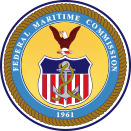Following conversations with the port directors in Los Angeles and Long Beach, ocean carrier chief executive officers, Southern California marine terminal operators, longshore labor leaders, and FMC Innovation Teams, Commissioner Rebecca Dye has identified approaches to address the four critical operational challenges at the San Pedro Bay ports identified by Innovation Teams. The Teams also suggested one action the Commission could take to facilitate discussion.
- Truckers should be directed to return empty containers to the terminal where they were picked up, allowing them to make dual moves and reduce the number of chassis required.
- Notice of terminal gate closures should be given no less than three days, and preferably seven days, before gate closing. At no time should a closure occur mid-shift.
- Notice of blank sailings should be given not only to beneficial cargo owners (BCOs), but also posted prominently on a carrier’s website, at least seven days in advance. Notice of bypassed ports should be posted at least 72 hours in advance.
- Carriers and terminals should immediately seek to collaborate regarding Export Cargo Receiving Timelines with the goal of better coordinating their interaction.
- That the Commission consider an Advisory Board consisting of ports, carriers, and MTOs in the interest of fostering and promoting greater collaboration across those three industry sectors.
Commissioner Dye added “I appreciate the willingness of our senior ocean carrier and marine terminal executives to address the four San Pedro supply chain operational challenges identified by the Innovation Teams. As we move into the third and fourth quarter of 2020, greater collaboration between ocean carriers and marine terminals will be critical to avoid cargo disruption and support a thriving American economy.”
DISCUSSION SUMMARY
- Empty Container Returns: BCOs and their drayage trucking agents have expressed frustration with untimely notice when carriers’ empty containers are not being accepted at one terminal and truckers are directed to an alternative terminal. The complexity of the process is increased because carrier alliance members may call at multiple terminals at Los Angeles and Long Beach. Most parties agreed that the ideal approach would be to direct truckers to return empties to the terminal where they had picked up the loaded container, allowing them to make a dual move and reduce the number of chassis required.
With limited exceptions, suggestions included: (1) terminals refraining from cutoffs of empty returns mid-shift, (2) terminals adopting a goal of 7 days advance notice, but no less than 24 hours, for empty cutoffs, and (3) terminals allowing appointment-free returns during low use periods (such as night gates). Commissioner Dye noted that some San Pedro Bay terminals have already instituted these, or similar, practices.
- Terminal Gate Closure Notification: Under current conditions, terminals may decide that expected cargo volumes may not financially justify maintaining full gate hours. But BCOs and drayage companies need timely notice of any gate closures. Participants have suggested that MTOs adopt a goal of 7 days advance notice, but no less than 3 days.
Commissioner Dye pointed out that BCOs and drayage companies could improve the situation by letting terminals know when they no longer need appointments. “Rapid cancellation of unneeded appointments can help the whole system run more smoothly, and reduce the chassis availability situation, too.”
- Blank Sailing and Bypassed Port Notification: Until cargo volumes begin to increase substantially, carriers will respond with blanked sailings to keep vessel supply matched to vessel demand. It is important to both American exporters and importers, especially smaller shippers and their freight brokers, that adequate notification is given. Participants in the Fact Finding discussions have suggested that, at a minimum, shippers and truckers get 7 days notice for blanked sailings, and 72 hours notice for port bypass decisions.
It is vital that ocean carriers communicate their plans in a timely way to all parties who, in turn, coordinate their businesses around cargo availability. Notification should be made available on carrier websites, as well as direct notification to shipper customers, to accommodate truckers and other parties.
- Export Cargo Receiving Timeline (ERDs and Cut-offs): With respect to export cargo, changes to ship arrivals (schedule integrity, blanked sailings, port bypass) can affect the cargo’s earliest receiving date (ERD) and cutoff date for loading the container – especially for inland-based rail users. Missed sailings and rolled cargo can have a profound effect on the exporters’ financial arrangements. Participants in the fact finding have suggested a minimum of 7 days notice of changed ERDs– but more notice, especially for inland-based exporters, would be better. In addition, carriers’ and terminals’ information on the exporter’s cargo receiving timeline needs to be closely coordinated to prevent conflicts.
Identifying these approaches is meant to assist stakeholders in addressing the operational challenges in San Pedro Bay, and is not intended to suggest that these approaches are required by the Shipping Act of 1984 or the Commission’s regulations.
FF29 REGIONAL APPROACH TO CONTINUE
Commissioner Dye stated that FF29 will continue a regional approach recommended by the Innovation Teams because freight delivery challenges differ in different ports around the country. She also noted that the Commission’s recently published guidance on demurrage and detention has been well-received and may already be contributing to better operational environment among affected parties.
Commissioner Dye will continue regional meetings to identify practical port operational goals that can improve the international supply chain.
Dye will soon engage with industry leaders operating through the Port of New York and New Jersey and the Port of New Orleans.

